
Reginald Innes Pocock F.R.S. was a British zoologist.

The Buthidae are the largest family of scorpions, containing about 100 genera and 1339 species as of 2022. A few very large genera are known, but a high number of species-poor or monotypic ones also exist. New taxa are being described at a rate of several new species per year. They have a [cosmopolitan] distribution throughout tropical and subtropical environments worldwide. Together with four other families, the Buthidae make up the superfamily Buthoidea. The family was established by Carl Ludwig Koch in 1837.
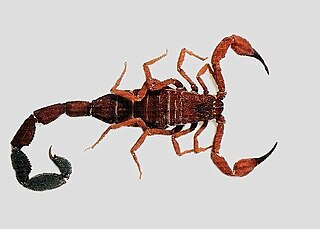
Tityus is a large genus of thick-tailed scorpions, the namesake of its subfamily Tityinae. As of 2021, Tityus contains more than 220 described species distributed in Central America and South America, from Costa Rica to Argentina. Species in the genus Tityus have been studied for hundreds of years, long before the taxonomic classification was put in place. Tityus tend to be of medium size for scorpions, roughly 50 to 70 millimeters long. They are dark brown or red in color, and can exhibit sexual dimorphism. They can live in a variety of environments, ranging from urban to arid mountains to the Amazon Rainforest. Tityus scorpions are best known for their venom and potent sting. The genus contains several dangerously venomous scorpions, the best known of which is the Brazilian yellow scorpion, T. serrulatus. Its venom can cause severe illness, and in the young, old and infirm even death. Some experts have argued that the genus as a whole may be paraphyletic, which could explain the knowledge gaps related to Tityus.
The taxonomy of scorpions deals with the classification of this predatory arthropod into 13 extant families and about 1,400 described species and subspecies. In addition, 111 described taxa of extinct scorpions are known.

Tityus exstinctus is an extinct species of scorpion belonging to the family Buthidae. It is only known from a single male collected in 1884 in the northern range of Martinique. The species epithet based on the fact that this taxon was already extinct when it was described.
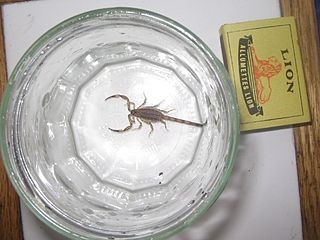
Isometrus is a genus of scorpion belonging and being eponymous to the family Buthidae. Some species are currently assigned to the genus Reddyanus.

The Chactidae are a family of scorpions established by Reginald Innes Pocock in 1893. They make up the superfamily Chactoidea.

The Scorpionidae make up the superfamily Scorpionoidea. The family was established by Pierre André Latreille, 1802.

The Euscorpiidae are a family of scorpions.

Urodacus is a genus of scorpion belonging to the family Urodacidae. It was described by German naturalist Wilhelm Peters in 1861. The type species is U. novaehollandiae. Its species are native to Australia, and dig burrows. The genus was placed in its own family in 2000. Before this, the group had been a subfamily Urodacinae within the family Scorpionidae.
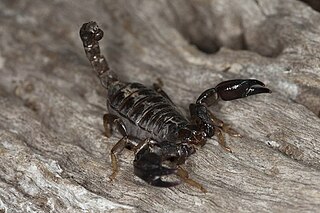
Urodacus manicatus, commonly known as the black rock scorpion, is a species of scorpion belonging to the family Urodacidae. It is native to eastern Australia.

Urodacus yaschenkoi, also known as the inland scorpion or the desert scorpion, is a species of scorpion belonging to the family Urodacidae. It is native to central Australia. It is also referred as the desert robust scorpion, because of its robust black colour and a long tail lined with a deadly hook.
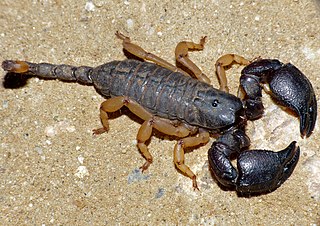
Hormuridae is a family of scorpions in the order Scorpiones. There are about 10 genera and more than 90 described species in Hormuridae.
Urodacus armatus, also known as the yellow sand scorpion or inland desert scorpion, is a species of scorpion in the Urodacidae family. It is native to Australia. It was first described in 1888 by British zoologist Reginald Innes Pocock.
Urodacus butleri is a species of scorpion in the Urodacidae family. It is endemic to Australia, and was first described in 2012.
Urodacus excellens is a species of scorpion in the Urodacidae family. It is endemic to Australia, and was first described in 1888 by British zoologist Reginald Innes Pocock.
Urodacus hoplurus is a species of scorpion in the Urodacidae family. It is endemic to Australia, and was first described in 1898 by British zoologist Reginald Innes Pocock.
Urodacus macrurus is a species of scorpion in the Urodacidae family. It is endemic to Australia, and was first described in 1899 by British zoologist Reginald Innes Pocock.
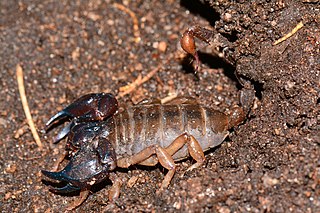
Urodacus planimanus is a species of scorpion in the Urodacidae family. It is endemic to Australia, and was first described in 1893 by British zoologist Reginald Innes Pocock.
Urodacus spinatus is a species of scorpion in the Urodacidae family. It is endemic to Australia, and was first described in 1902 by British zoologist Reginald Innes Pocock.













